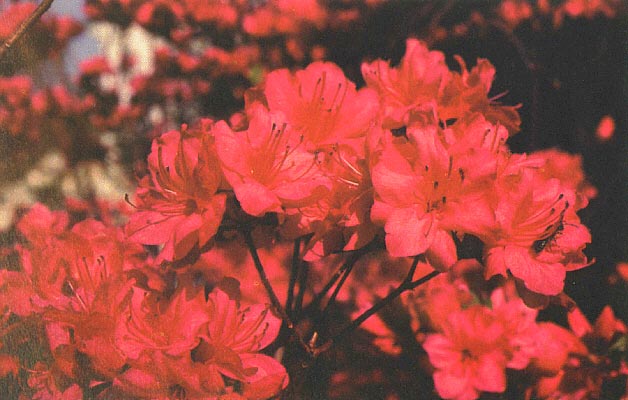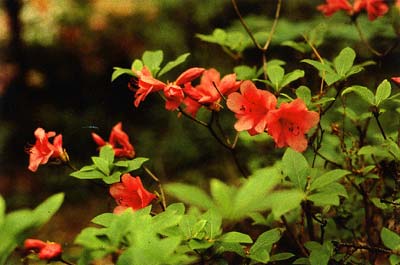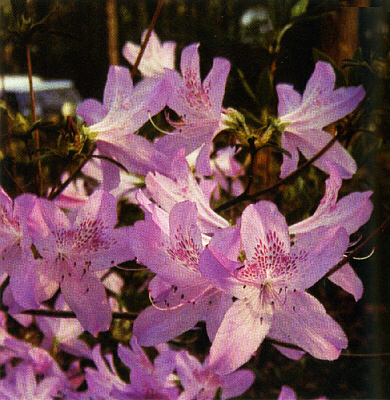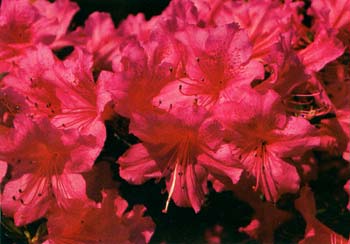THE GABLE AZALEAS
by George W. Ring, Fairfax, Virginia
For some time before starting this article, I thought about how to approach the subject. Should it concentrate on the person of Mr. Joseph Gable, on his plants, on his continuing influence on the plant world or perhaps on the more general subject of hybridizing azaleas to show the considerable influence of Mr. Gable and his azaleas on the horticultural trade and on the further development of hardy varieties? As a part-time hybridizer myself, this last approach seemed reasonable, and much of the material presented here will be about Mr. Gable's hybridizing with azaleas,
with some additional comments about him as a very special person.
Fortunately for me, the research for the book, "Hybrids and Hybridizers", provided some basic information on the development of the Gable azaleas that would otherwise have been unavailable. Information supplied by the late Dr. Wheeldon of Richmond, Virginia, and by George S. Lee, Jr. in Connecticut has been of considerable help, as well as Mr. Gable's own notes, and some clues recently furnished by his daughter, Caroline, who, with one of Joe's grandson's, David Gable, continues to preserve and protect the Gable legacy of azaleas and rhododendrons in Stewartstown, Pennsylvania.
In my own garden, the Gable azaleas are the most dependable and floriferous of any. How did they get that way? Mr. Gable began his azalea hybridizing some 60 years ago, and information on hybridizing and growing techniques, as well as suitable parents, was scarce. We are not certain if he was aware then of all of the more than 50 species of evergreen azaleas and numerous hybrids which might have been useful to achieve the goal of evergreen azaleas hardy in Stewartstown. It should be noted that most of the hybrids known then were the Southern Indicas - not nearly hardy enough for him to use in hybridizing. The Kurumes were not imported until 1918 - and many of them were too tender, also. Even Hinode giri (Red Hussar), probably the most well known of these, is occasionally killed to the ground in Stewartstown. Koster's azaleas were
not known in the U.S. until later in the 1920's, and the Satsuki's in the late 1930's. So, in 1920, where do you start and what would you strive for in plant form - flower, color, flower type, etc.?
The development of new azaleas could not occupy his full time because Mr. Gable had recently married, was starting his family and making his living as a general farmer and fruit grower. Just what is it that inspires a man to concentrate so much thought and effort to develop evergreen azaleas suitable for colder areas in the eastern U.S.? A lack of television to occupy his time? Most doubtful. More likely it was his very curious mind combined with a restless spirit. Mr. Gable studied nature and plants from childhood throughout his life, always trying to understand their lessons, and he actually learned by keen observation far beyond what could be gleaned from his. careful study of the few books available to him. Whether by luck, or by study, the records show that Mr. Gable acquired the azalea-species
R. yedoense
var.
poukhanense
in 1920.
R. yedoense
var.
poukhanense
is also known as the Korean azalea, native to central and south Korea and to several islands off the coast. Compared to most other evergreen azaleas it is very hardy, especially in selected forms. The flowers are 2 inches or more across, rose to lilac purple and noticeably fragrant. It loses most of its leaves during winter in colder climates.
R. yedoense
var.
poukhanense
was introduced to this country from seeds sent by J. G. Jack in 1905 to the Arnold Arboretum. Perhaps this is where Mr. Gable obtained his plant as he very early corresponded with Dr. Ernest Wilson and Professor Charles Sargent at the Arboretum. Mr. Gable notes that the Gable azaleas would not have been possible without the ever present help of
R. yedoense
var.
poukhanense
in their ancestry.
Nothing much seems to have happened with the rose-purple azalea until, in 1926, Mr. Gable acquired the species
R. kaempferi
and a few selected hybrids. As we know now,
R. kaempferi
is another outstanding species for the development of hardy evergreen azaleas. It is native to the Japanese island of Kyushu, upright habit, 7 to 9 feet tall, normally with 2-inch orange-red flowers, often with a darker blotch and a long tube. The species varies considerably in color, flower size and flower shape. Judging from a black-and-white photo provided by Caroline Gable, the form of
R. kaempferi
grown by Mr. Gable had flowers larger than 2 inches, and it had a prominent blotch. His plant, like his
R. yedoense
var.
poukhanense
may have also come from the Arnold Arboretum, or perhaps grown from seed. Since there are still some very old plants at the Gable place, the latter seems more likely. In his hybridizing, Mr. Gable used one of his plants which he considered superior to others from which he selected. Caroline noted that many seedlings "volunteered" around the base of his selected plant.
R. kaempferi
is another hardy evergreen azalea, but not as hardy as
R. yedoense
var.
poukhanense
.
The records are not clear as to whether Mr. Gable tried other azalea crosses first, but it is certain that the crossing of
R. yedoense
var.
poukhanense
with
R. kaempferi
established the foundation for the large majority of his azalea hybrids. A rose-purple flower of a hardy species crossed with another hardy species having an orange-red flower! The first generation of this cross, as well as seedlings of later crosses, were lined out in full sun along the street in Stewartstown and allowed to grow with almost complete disregard for insects, watering, wind and fertilizer. The seedlings had to fend for themselves, and in doing so, the best plants proved themselves. There were many casualties, but in the passing years, a few were selected for hardiness, plant habit and best colors. One of the first plants selected from this primary cross of
R. yedoense
var.
poukhanense
and
R. kaempferi
was named "Big Joe" for its vigor and larger than average pinkish-lavender flowers. Mr. Gable notes that "Big Joe" seems a little hardier than either of its parents. The color improves as the flowers age - and it is a knockout with its early bloom when little else is showing color. It eventually needs much room.
Now, what can be done to expand the range of colors and flowers in this hardy, persistent leaved azalea? Mr. Gable continued his hybridizing by combining the azaleas "Mucronatum",
R. indicum
and "Hexe", plus a few others, with either
R. yedoense
var.
poukhanense
,
R. kaempferi
or a combination of the two. A few of his hybrids are the result of growing a second generation of the basic
R. yedoense
var.
poukhanense
x
R. kaempferi
cross. Mr. Gable notes the following about some of the other azaleas he selected as parents:
| 'Mucronatum' |
- "Acquired in 1927, often loses its flower buds but is a show every 2 or 3 years."
It is a Chinese hybrid of uncertain origin introduced into England in the 1800's. |
| R. indicum | - "Not hardy in Stewartstown but its late flowering is of value and this is transmitted |
|
to its progeny." 'Hexe' - "Acquired in 1926, this managed to live outdoors for 24
years - sometimes frozen back - a fertile source of hardy red hybrids." |
Anxious to understand how 'Hexe' could be of so much value, I looked for its parentage in the 1958 International Register. Imagine my disappointment on finding not one, but ten forms of 'Hexe'. On closer inspection, I found that only one was registered early enough to be the one used by Mr. Gable. This one is registered as R. obtusum var. amoenum x R. simsii , 'Duc de Nassau'. Now R. obtusum var. amoenum is a small flowered but very hardy evergreen azalea, and it has been my experience that R. simsii is not very hardy, but transmits strong root systems to its hybrids. Perhaps these characteristics account to some extent for Mr. Gable's successes with 'Hexe' as a parent.
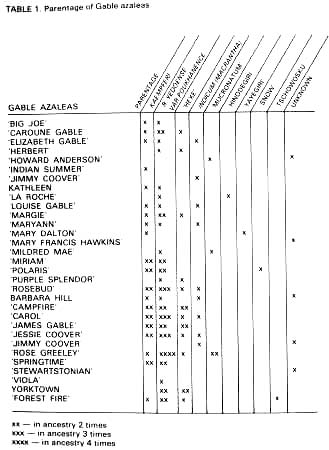
|
Table 1 shows how these parents were combined to produce some of the Gable azaleas. Of the hybrids listed, only 'Howard Anderson' and 'Jimmy Coover' are certain to have neither
R. yedoense
var.
poukhanense
nor
R. kaempferi
in their background.
In addition to 'Big Joe', other early introductions by Mr. Gable are named 'Elizabeth Gable', 'Louise Gable', and' Maryann'. All three of these are derived from the cross of (
R. yedoense
var.
poukhanense
x
R. kaempferi
x
R. indicum
). And all of these are fairly late season blooming as is
R. indicum
. 'Elizabeth Gable' was first selected for its evergreen character - and is the most dependable hardy azalea we have with this character. "Salmon pink, late and a large grower." 'Louise Gable' - many people agree with Mr. Gable that this is one of his finest. "In the sun it is of good plant habit without pruning." - a double salmon pink, very hardy and dependable, midseason. 'Maryann' - "From the same lot of seedlings as 'Louise Gable'. This was neglected for a while until a row of plants of it in the open field grew into fine little specimens and proved to be of iron-clad hardiness. The color is not too bright, though pleasing - healthy, hardy and easy to grow. About the only grouch we can think up is that the rabbits are extremely fond of its twigs and buds in winter. So called in the hunters - and cats. Here a good fox terrier does wonders. An easy one to root." Lavender pink with a darker blotch.
'Mary Dalton' is another early season bloomer - about the same time as 'Big Joe'. Mr. Gable says, "Named for my wife who regards this as better than 'Chinook' which it closely resembles. The flowers of 'Mary Dalton' are more inclined to be lax in habit." (Almost pendant when wet with rain.) It is a brilliant orange, single, hose-in-hose; it roots easily. Best in part shade as the flower color burns in bright sun. 'Mary Dalton' is a cross of
R. kaempferi
x 'Yayegiri' (syn. 'Yaye-hiryii'), an orange-red kurume hybrid sometimes known as 'Scarlet Prince'.
And now we come to the use of 'Hexe' as a parent of the Gable azaleas.
'Herbert' -
R. yedoense
var.
poukhanense
x 'Hexe', introduced in 1931. Hose-in-hose, frilled. Early mid-season with twiggy growth (in sun). Many, including myself, have trouble distinguishing the flower from that of 'Purple Splendor' (the same cross). In habit, 'Herbert' seems to be more spreading - if my plants are properly identified. Mr. Gable comments: "hose-in-hose, magenta. In spite of this color description, those who see it in flower buy it 9 times out of 10. My own sense of color values, unhampered by the educational efforts of the orthodox, and influenced only by what I see and what 1 like, finds no quarrel with a good magenta shade any more than with a good red, yellow, pink, blue or what have you. Obviously, many of my customers' ideas of color are untrammeled by educational allergies."
'Caroline Gable' - Another early introduction with 'Hexe' in its parentage - (
R. yedoense
var.
poukhanense
x 'Hexe') x (
R. yedoense
var.
poukhanense
x
R. kaempferi
). It is bright red, with a darker blotch, late midseason. Mr. Gable notes that it is one of the brightest things in the landscape when in full flower. The flower buds only occasionally are hurt at Stewartstown. Like 'Hexe", it buds fully in the sun, somewhat less in the shade.
Not all of the Gable azaleas are hybrids. 'Indian Summer' (syn. 'October') is a form of
R. kaempferi
selected for its habit of blooming in the late fall, and then again in the spring. It is a pinkish salmon, that is a very attractive color. For me it does best in considerable shade on a north slope. It likes more moisture than some. Quoting Mr. Gable, "Pure
R. kaempferi
as far, as I can ascertain, but it flowers regularly in late fall. It is peculiar in that all the flower buds formed are two to three times the normal size of
R. kaempferi
buds. On the average, about half of these open in the autumn and the remaining still flower in the spring. In seasons of plenteous rainfall this azalea is strikingly colorful into November. The fall flowers last a long time if there is no hard freeze."
Gillin's Red (G-1-G) - This azalea, propagated by Mr. Gable, was actually from Jim Gillin - of unknown parentage. "A late red flowering azalea much different from our familiar type of later flowering plants in new growth - and about brick red. The azalea fancier will make room for this."
Some of Mr. Gable's own hybrids are also of unknown parentage in spite of his careful record keeping. Four of these are:
'Stewartstonian' - A brilliant pure red of impeccable habit, and with striking winter foliage and maroon-bronze flower buds.
'Howard Anderson' (syn. 'H. W. Anderson') - probably a 'Mucronatum' hybrid, pale blush flowers prettily spotted on the inside on a dense, compact, slow growing plant. Named for a neighbor, now gone on, who much admired it.
'Mary Francis Hawkins' - This was a particular favorite of Mr. Gable's. "A tall growing sort with medium deep pink hose-in-hose flowers that glow with some indefinable yellow or orange suffusion." Small plants are leggy, and require room and several years to develop their true character
'Jimmy Coover' - An
R. indicum
hybrid, flowers red. The plant is low spreading and late.
Two selected plants of second generation crosses of
R. yedoense
var.
poukhanense
and
R. kaempferi
are 'Springtime' and 'Miriam'.
'Springtime' - is a bright pink with the flower color aging in a way so its blotch becomes more prominent. It is quite hardy and early, about the same time as 'Big Joe'.
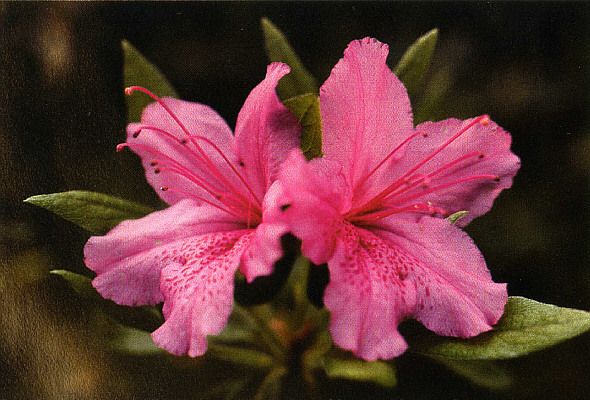
|
|
R. 'Miriam'
Photo by Betty Sue Harding |
'Miriam' - is a hardy bright pink which blooms a week later than 'Springtime'.
'Mildred Mae' -
R. yedoense
var.
poukhanense
x 'Mucronatum' "Selected because it is much more compact and dense growing than 50G and 51 G. It will require as much room as the others, and bears equally lovely flowers more fragrant than most." After 50 years the original plant is only 5 ft. high and 35 feet across.
'Polaris' - A white seedling of 'Springtime' x 'Snow'. It is very floriferous and has a characteristic of becoming very twiggy with age - and with a flower on every small twig.
|
|
'Barbara Hille' - is one of the slowest growing Gable azaleas, a good salmon with single flowers. So far, I have been unsuccessful at using this as a seed parent.
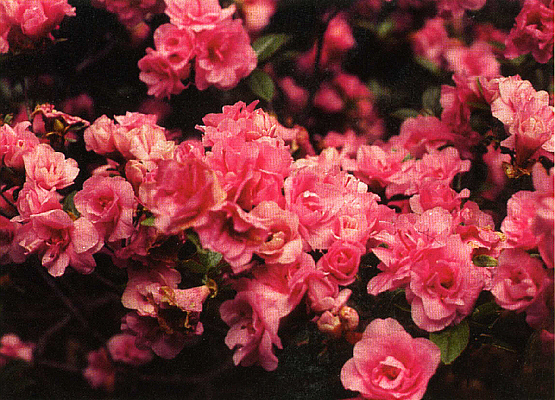
|
|
R. 'Rosebud'
Photo by George Ring |
'Rosebud' - ('Louise Gable' x 'Caroline Gable') There seems to be a number of different plants all labeled Rosebud in the trade. The true "Rosebud" as I know it is slower growing, has tighter flowers with more red color in the bud stage and when partially open. Some faster and taller growing azaleas having "Rosebud" like, shell pink flowers, more commonly found in the trade, may be Gable's 'Lorna'.
'Carol' - from the same cross as 'Rosebud' is much like 'Caroline Gable' but is more dwarf and spreading.
'La Roche' - ('Hinode giri' x
R. yedoense
var.
poukhanense
) "Hardy, vigorous, floriferous and magenta'. Recommended for trial where hardiness is azalea public enemy no. 1. The flowers are early, not exceptionally long-lasting, and a welcome sight after along cold winter." It is more attractive with some yellow daffodils nearby.
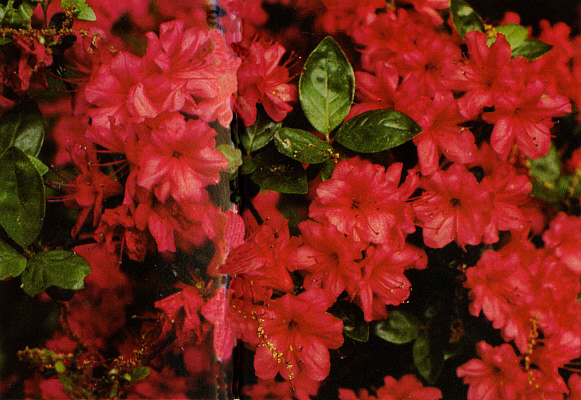
|
|
R. 'Campfire'
Photo by George Ring |
'Campfire' - A particular favorite of mine - a cross of 'Caroline Gable' x 'Purple Splendor'. The blooms last a long time, even though it comes into flower after most of the Kurumes, when the weather is often warmer. It is one of the better red azaleas and can put down even 'Hino-crimson' in color, size of flower and hardiness.
'Rose Greeley' - The only white Gable azalea mentioned thus far has been 'Polaris'; however, by Mr. Gable's notes he planned all along to develop a very hardy white azalea - hardier than any then in existence. These notes provide a better understanding of just how farseeing and exceptional was this man in his quest for a new race of azaleas.
" 'Rose Greeley' is a white, hose-in-hose and so far is hardy. The Russians have their five-year plan, etc.; but the development of this azalea is the result of a 16-year plan, though no one knew how long it would take in the beginning. Many people, including some plantsmen, think that hybridization is just a matter of crossing species and varieties and then waiting for something to turn up. And maybe all too often, it is conducted along these lines. Neither will I commit perjury! But if knowledge is lacking, 'experimentia docet', and it is little short of tragic if a would-be hybridist spends too many years of the only life he has attending her school. Definite objectives should be set, and whether or not we can attain them, a comprehensive long time plan (but as short as we can make it) will bring us a lot closer to that attainment a lot sooner in this lifetime."
The plan for 'Rose Greeley' was:
1.
R. yedoense
var.
poukhanense
x 'Mucronatum' to get a hardy white; 400 seedlings, none white.
2. Above selfed, 240 seedlings flowered,
3 single whites.
1 a.
R. yedoense
var.
poukhanense
x 'Hexe' to get a hardy hose-in-hose. All seedlings rose-purple.
2a. Above x (
R. yedoense
var.
poukhanense
x
R. kaempferi
) to obtain lighter colors in hose-in-hose form. Several fine pinks.
3. Crossed white from No. 2 with hose-in-hose pink from No 2a. Flowered nearly 200, and got 1 hose-in-hose white which is a hardier white than we ever grew before. "But I still think I made this cross in a country cemetery, dark of the moon, and with a rabbit's foot in each pocket."
After studying the plan above, one might compare the development of the Gable azaleas with Columbus" rebuttal to those who claimed that his discovery of America was a small feat. When Columbus asked his detractors to stand a raw egg on end and they could not, he succeeded by placing the egg in a small pile of table salt. "That's easy'", they exclaimed, to which Columbus replied, "if you just know how". Development of the Gable azaleas may seem simple, now, but is in fact only so, "if you know how".
This discussion has not covered all the Gable azaleas and it should be noted that Mr. Gable did name quite a few others, some of which he continued to propagate intermittently through the years. Table 2, furnished by Mr. George Lee, Jr., shows which years Mr. Gable carried particular azaleas in his catalog listings.
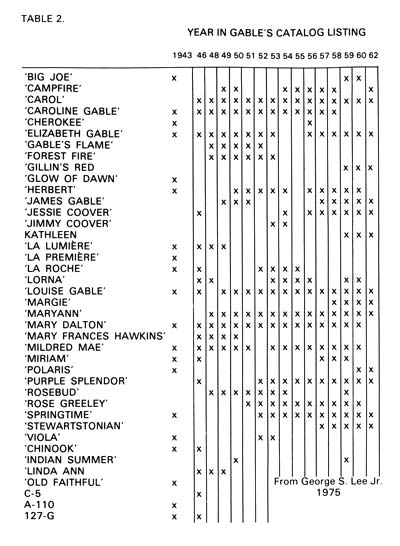
|
Between 1943 and 1962, 'Big Joe' was listed only 3 years, while 'Mary Dalton', easily propagated, was listed almost every year. In many years, the demand for his azaleas exceeded Mr. Gable's ability to provide the 3 and 4-year old sizes he thought best for his customers. In other instances, he reevaluated his azaleas and either added more to his listing or dropped those superseded by an improved selection.
|
|
|||||
|
|
|||||
Some so-called Gable azaleas were actually named by others who purchased seedlings, and so we have 'Corsage', 'Susan', 'Cameroon', 'Claret', 'Swan', 'Charlotte', 'Billy', 'Boudoir' and others.
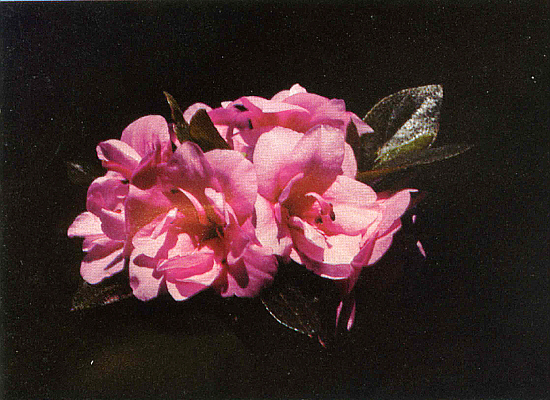
|
|
'C-12-G'
Photo by Betty Sue Harding |
And some Gable azaleas are still grown under number, as C-12-G, A12-G, U-1-G, J-3-G, etc.
Whatever they were named, or by whom, the Gable azaleas have found a permanent place in the gardens of the United States and other countries. In England, both 'Rosebud' and 'Stewartstonian' have received high awards.
Because of their recognized value as hardy and attractive plants, the Gable azaleas have been parents of many new varieties, including Kehr's 'White Rosebud'; Lanny Pride's Sam, Winnie and others; Tony Shammarello's' Helen Curtis' and 'Elsie Lee'; and Henry Yate's 'Frostburg'. Robert Gartrell, in developing his Robin Hill hybrids, also found the Gable azaleas to be good parents, as evidenced by his 'Lady Louise' and many others which owe some of their good character to 'Louise Gable' and other Gable hybrids.
These new azaleas developed by more recent hybridizers would please Joe Gable, for no one knew better than he that the plant world does not stand still. Even now there is work going on to develop even hardier azaleas, larger flowered azaleas, azaleas that flower over a longer period, azaleas better suited for bonsai culture, and other improvements. Fortunately for all of us, Joseph Gable provided a giant leap forward with the development of his azaleas, and they are now achieving their rightful recognition and are providing a solid foundation for the future.
